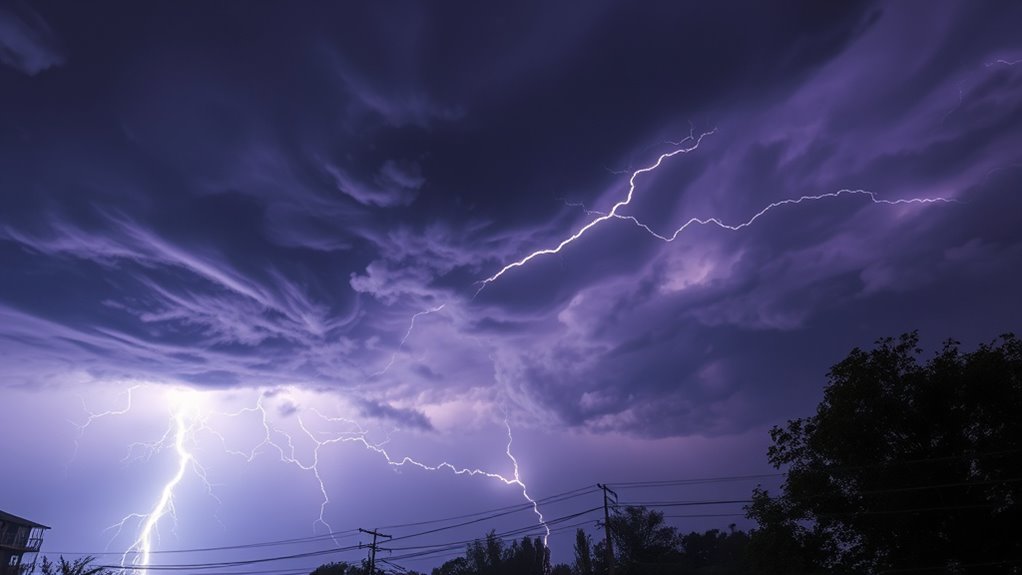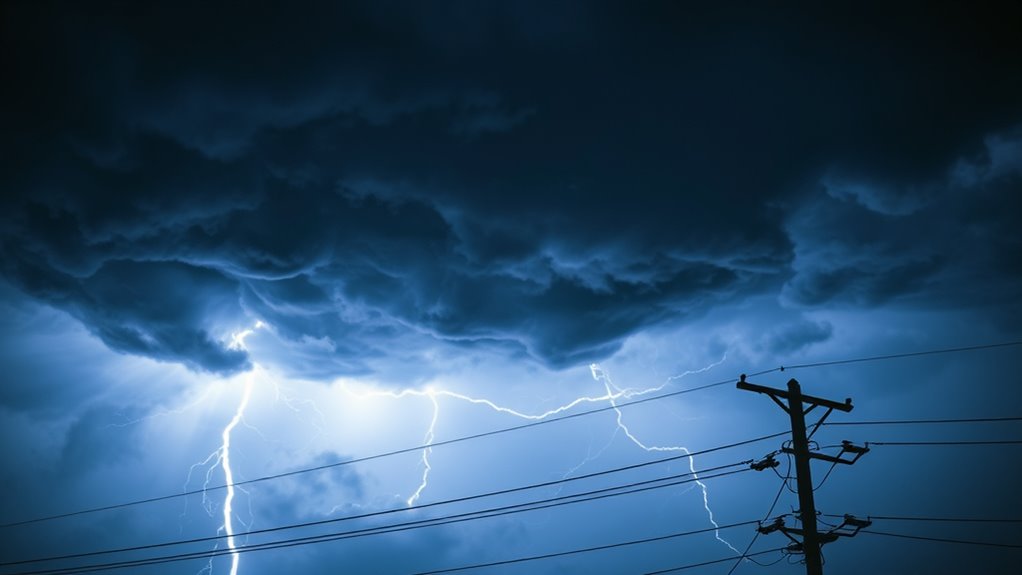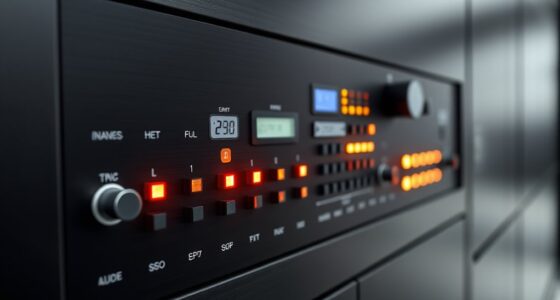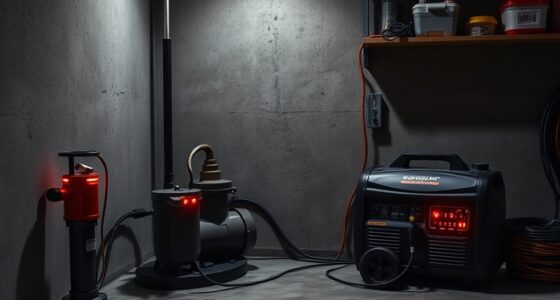Lightning protection systems help direct strikes safely into the ground, protecting your property and electronics. Surge protectors guard against voltage spikes caused by lightning or utility changes. Proper grounding and bonding are key to prevent damage and guarantee safety. Many myths surround these systems, but effective design and regular maintenance keep everything working well. If you want to understand how these systems work and stay protected, you’ll find useful details ahead.
Key Takeaways
- Lightning protection systems safely direct strikes into the ground using rods, conductors, and grounding components to prevent fire and damage.
- Surge protectors absorb voltage spikes, diverting excess energy away from electronics, especially when properly grounded.
- Proper installation and regular maintenance of grounding and surge devices are essential for ongoing safety and effectiveness.
- Lightning can strike the same area repeatedly and induce surges through electrical wiring, plumbing, or nearby electromagnetic fields.
- Indoor safety involves comprehensive protection measures, including surge protectors and proper grounding, to prevent damage from indirect lightning effects.
What Is Lightning Protection and Why Is It Important?

What exactly is lightning protection, and why should you care about it? Lightning protection is a system designed to safely direct lightning’s electrical energy into the ground, preventing damage. It doesn’t stop lightning from striking but controls where the current travels. Typically, it involves metal rods (lightning rods) placed on high points of your building to intercept strikes. Conductors connect these rods to grounding electrodes buried underground, channeling the energy safely away. The goal is to reduce fire risks, structural damage, and harm to people and electronics inside. With more severe storms and our growing reliance on technology, protecting your property becomes even more critical. Proper lightning protection minimizes costly repairs, data loss, and injury risks, making it a crucial safety investment for any structure. Additionally, modern lightning protection systems are designed to adapt to changing weather patterns, which further enhances their effectiveness in safeguarding your property. Understanding the components of a lightning protection system helps ensure your setup is comprehensive and effective.
Key Components of Lightning Protection Systems

A lightning protection system relies on several key components working together to safely direct lightning strikes into the ground. Air terminals, or lightning rods, are installed at the highest points, made of copper or aluminum, and designed to intercept strikes. Conductors connect these rods to grounding systems, providing a safe pathway for current. Grounding systems, consisting of rods or plates embedded in the soil, disperse lightning energy safely into the earth. Bonding components ensure all metal parts are electrically connected, preventing dangerous voltage differences. Surge protection devices, like spark gaps and suppressors, are installed at power entry points and critical equipment, limiting voltage surges caused by lightning. Proper installation and regular maintenance are essential to ensure the system functions effectively. The grounding system disperses high-voltage energy safely and effectively, reducing the risk of damage. Together, these components form an effective system to protect your structure from lightning damage.
How Surge Protectors Work to Safeguard Equipment

When a surge hits, your protector responds almost instantly to limit the voltage spike. It does this by diverting or absorbing the excess energy, preventing it from reaching your devices. This quick action is vital to keeping your equipment safe from damage. Surge protectors use internal MOVs to absorb and divert excess voltage, which helps to reduce the risk of harm during unexpected power fluctuations. Additionally, the essential oils for surge relief can provide a calming effect for those concerned about electrical safety.
Rapid Voltage Response
Rapid voltage response is essential for surge protectors to effectively shield your equipment from damaging spikes. With response times measured in nanoseconds, SPDs react swiftly enough to clamp voltage before it harms sensitive electronics. Devices with response times under 5 nanoseconds, especially those under 1 nanosecond, provide superior long-term protection. Since most surges develop over microseconds, this quick response prevents high-voltage peaks from reaching your devices. The SPD’s ability to act almost instantly means it can suppress surges at their onset, reducing the risk of dielectric breakdown or component damage. While response time is important, it works best when combined with effective voltage clamping and current diversion. This quick activation ensures your equipment stays safe during sudden power fluctuations caused by lightning or other electrical disturbances. Understanding surge protection mechanisms can help you choose the best device for your needs.
Divert Excess Energy
Surge protectors safeguard your equipment by using metal oxide varistors (MOVs) that act as voltage-sensitive switches. Under normal voltage, MOVs stay inactive, but when voltage spikes above a set threshold, they activate to divert excess energy safely to the ground wire. They absorb the surge’s high voltage, converting it into heat and creating a low-resistance path that channels the surge current away from your devices. Proper grounding is essential; a good earth connection ensures the diverted energy dissipates safely into the ground, protecting your equipment. When a surge occurs, the MOV’s resistance drops, allowing the excess voltage to flow to ground. If the surge exceeds the protector’s ratings, internal components can fail, so regular checks and replacements are necessary for continued protection. Incorporating rustic decor and natural materials can enhance the farmhouse aesthetic and help create a cozy atmosphere that also supports the proper functioning of your electrical systems.
Designing Effective Lightning and Surge Protection Systems

Designing effective lightning and surge protection systems requires a strategic approach that integrates key components to safeguard structures and equipment. You must select strike termination devices, like air terminals, positioned at least 10 inches above the roof and spaced no more than 20 feet apart. Conductors, made from corrosion-resistant metals such as copper or aluminum, should avoid electrolytic couples. Grounding systems, with rods at least 8 feet long, safely transfer lightning currents into the earth. Bonding ensures all metallic systems are interconnected to prevent sideflashing. Surge protection devices (SPDs) at service entrances and critical points mitigate voltage surges. Proper design involves aligning components with standards like NFPA 780 and UL 96A for maximum safety and durability. Incorporating wall organization systems can also help in maintaining clear access to electrical panels and surge protection devices, ensuring safety and ease of maintenance.
| Component | Material | Specification |
|---|---|---|
| Air Terminals | Copper/Aluminum | ≥10 inches above roof, ≤20 ft apart |
| Conductors | Copper/Aluminum | Corrosion-resistant, avoid electrolytic couples |
| Grounding Rods | Steel | ≥8 ft long, buried 10 ft deep |
| Bonding Conductors | Copper | Sized per code, connect metallic systems |
| SPDs | Various | Rated for high impulse currents, placed at key points |
Common Myths About Lightning and Surge Protection

Many common beliefs about lightning and surge protection are actually misconceptions that can lead to inadequate safety measures. For example, a lightning rod alone doesn’t fully protect your building. It’s just one part of a system that requires properly installed conductors and a solid grounding system to safely direct lightning into the earth. Lightning rods are only part of the overall lightning protection system. Proper installation is crucial to ensure effectiveness and safety. Similarly, many think lightning never strikes the same place twice, but tall structures like the Empire State Building get hit over 100 times annually. Some believe surge protectors alone offer complete protection; however, they only guard against transient surges and can’t handle a direct lightning strike. In conclusion, thinking you’re safe indoors during a storm is false—lightning can enter through wiring, plumbing, or even windows. Always follow extensive safety and protection strategies, including understanding lightning entry points.
The Role of Grounding and Bonding in Safety

Understanding the importance of grounding and bonding is key to maintaining electrical safety, especially during lightning and surge events. Grounding connects your system to the earth, providing a safe path for fault current and preventing shocks or fires. Bonding links all metal parts to ensure they share the same electrical potential, reducing the risk of dangerous voltage differences. Proper connections, like deep ground rods and clean, secure bonds, are essential for safety and surge protection. The table below highlights key aspects:
| Aspect | Purpose | Importance |
|---|---|---|
| Grounding | Dissipates fault current safely | Prevents shock and fire |
| Bonding | Equalizes electrical potential | Stops sparks, arcs |
| Compliance | Meets NEC safety standards | Ensures system reliability |
Maintaining these connections keeps your system protected during lightning strikes and surges. Regular inspections help ensure grounding and bonding remain effective over time.
How Lightning and Surges Can Damage Electronic Devices

Lightning and surges can send sudden voltage spikes through your devices, damaging sensitive circuits and components. These high-voltage events can overload electronics, causing immediate failures or subtle degradation over time. Additionally, induced currents from nearby strikes can travel through wiring and cables, posing an ongoing threat to your equipment’s safety and functionality. Recognizing the risks associated with electricity surges can help you better protect your electronics.
Voltage Spikes Damage Circuits
Voltage spikes caused by lightning and power surges can rapidly damage electronic devices by exceeding their maximum voltage limits. Lightning strikes can produce voltage spikes over 10,000 volts in microseconds, destroying circuits instantly. Utility switching events cause surges of 200-400 volts that last a few milliseconds, risking component failure. Internal sources like motor startups generate 150-300 volts over several milliseconds, causing moderate damage. These brief but intense spikes create current surges that can surpass a device’s breakdown voltage, leading to catastrophic failure. Excessive current triggers avalanche breakdown in semiconductors, destroying delicate parts. High-voltage pulses can discharge electromagnetic energy, causing insulation breakdown and shorts. Over time, repeated voltage spikes weaken circuits, increasing the likelihood of permanent damage or complete device failure. Understanding electrical safety can help protect your devices from these damaging events.
Induced Currents Threaten Devices
Have you ever considered how a nearby lightning strike can quietly damage your electronic devices without direct contact? When lightning occurs, it creates rapidly changing magnetic and electric fields that induce currents in nearby metal conductors through electromagnetic induction. Long wires like cables and wiring act as unintended antennas, increasing the induced voltage and current based on their size and proximity to the strike. These induced voltages can surpass what your devices are designed to handle, causing immediate or latent damage—even without a direct lightning hit. Sensitive components, especially at the cable ends, are highly vulnerable because the induced surges can exceed their small voltage tolerances. This invisible threat can quietly weaken or destroy your electronics over time, often without obvious signs of a lightning strike. Electrical experts analyze damage patterns, electricity paths, and components at detailed levels (e.g., printed circuit boards) to better understand and mitigate these risks. Additionally, understanding the induced currents caused by electromagnetic fields can help in designing more effective protective measures for electronic devices.
Best Practices for Maintaining Your Lightning Protection System

Maintaining your lightning protection system requires ongoing diligence to guarantee it functions effectively when needed. Regular inspections help identify corrosion, damage, or loose connections. After severe weather or lightning strikes, assess the system’s integrity promptly. Ensure conductors, air terminals, and connectors are secure and undamaged. Keep detailed records of inspections and repairs to track system health. Conduct electrical testing, such as grounding resistance checks, at least every 3 to 5 years, and verify surge protectors and conductors are functioning properly. Address corrosion or damage immediately, replacing components with durable, corrosion-resistant materials. Tighten loose connections and clean components to prevent failures. Regular maintenance also helps detect early signs of deterioration, which can prevent costly repairs later. Early signs of deterioration are often subtle but critical to address promptly. Regular maintenance reduces risks and extends your system’s lifespan. Incorporating proper grounding techniques into your maintenance routine can further enhance system reliability. Use this table as a quick reference:
| Maintenance Task | Frequency |
|---|---|
| Visual Inspection | Annually and after storms |
| Ground Resistance Testing | Every 3-5 years |
| Surge Protector Checks | Quarterly |
| Repair Damages | As needed |
| Record Keeping | Ongoing |
Frequently Asked Questions
How Do I Know if My Lightning Protection System Is Working Properly?
You can tell if your lightning protection system is working properly by performing visual inspections for damage, corrosion, and loose connections. Conduct continuity tests to ensure all parts form an unbroken low-resistance path, and measure earth resistance to verify proper grounding. Additionally, test surge protection devices for peak discharge capacity and insulation integrity. Regularly scheduled inspections, testing, and documentation help confirm your system’s effectiveness and safety.
Can Lightning Strikes Occur Without Visible Damage to My Property?
Can lightning strike your property without leaving visible damage? Absolutely. Lightning can deliver powerful surges that travel through wiring, causing internal damage you can’t see. Think of it like an invisible assassin — silently harming your electronics, wiring, and underground systems. Even if everything looks fine, flickering lights or tripped breakers may signal unseen trouble. Always get a professional inspection after a storm to guarantee safety and prevent hidden damages.
What Is the Difference Between a Surge Protector and a Lightning Arrester?
A lightning arrester protects your entire electrical system by diverting large lightning strikes directly to the ground, preventing major damage. A surge protector, on the other hand, shields your electronic devices from smaller, residual surges caused by lightning or other faults. While arresters handle high-voltage, high-current surges at the system level, surge protectors work at lower voltages inside your home to safeguard sensitive electronics.
How Often Should I Inspect or Test My Lightning Protection Components?
You should inspect your lightning protection components at least annually—because, surprise, lightning doesn’t wait for your schedule. Critical or high-risk buildings might need more frequent checks, especially after storms or damage. Formal inspections every three years with yearly visual checks are common. Remember, after any modification or severe weather, a prompt inspection is vital. Testing every 11 to 12 months helps ensure your system stays effective and compliant.
Are There Specific Safety Precautions During Lightning Storms?
During lightning storms, you should seek shelter indoors in a sturdy building or a metal vehicle with windows up. Stay away from windows, doors, and metal objects, and avoid plumbing and electrical devices. If outside, move to lower ground away from tall objects and avoid open spaces. Suspend outdoor activities immediately, and wait at least 30 minutes after the last thunder before resuming. Always monitor weather updates for safety.
Conclusion
By understanding lightning and surge protection, you’re armed with a shield stronger than steel against nature’s fiercest fury. Implementing proper systems and maintenance can save your electronics from destruction, preventing chaos and costly repairs. Remember, neglecting these safeguards is like inviting a thunderstorm to dance on your devices—an almost unstoppable force. Stay vigilant, stay protected, and keep your digital world safe from lightning’s wrath with simple, effective steps.










